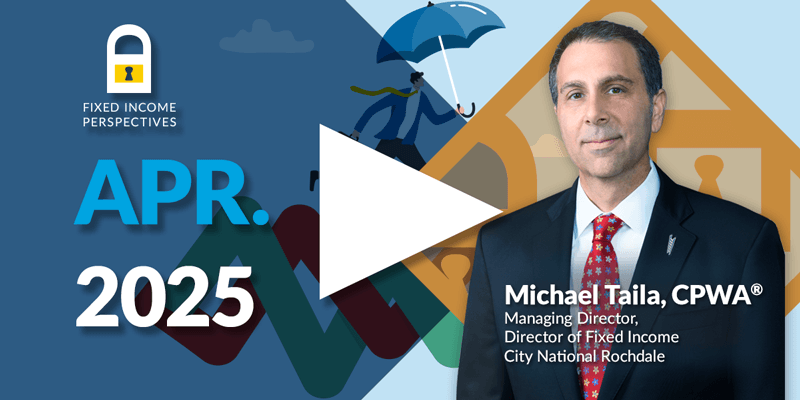-
Economic Perspectives
Federal Debt: A Fiscal Year End Update
October 2024
- Filename
- Economic Perspectives OCTOBER 2024.pdf
- Format
- application/pdf
TRANSCRIPT
Back in March, the Economic Perspectives video delved deeply into the federal debt, and it brought up a considerable amount of interest and many follow-up questions from you, so thank you. Now, with the federal government's fiscal year ending just this past Sept. 30, we thought giving an update on this would be a good idea. So, let's go to the charts.
Chart 1: Federal Debt
$, trillions

Data current as of October 29, 2024
Source: U.S. Treasury
Information is subject to change and is not a guarantee of future results.
Chart 1, 0:35– This chart shows the federal debt since 1900. You can see that it has rocketed in growth since 1980 and has now reached $35.5 trillion. There are many reasons for this rapid growth in the past 45 years, most notably the soaring growth in the economy.
Chart 2: Federal Debt: Yearly Change
% change of each fiscal year

Data current as of October 29, 2024
Source: U.S. Treasury
Information is subject to change and is not a guarantee of future results.
Chart 2, 0:56– This chart shows the percentage increase in the federal debt for each of the years since 1950. You can see that the average growth has been just under 7% annually. There've been a few spikes as of late: COVID-19, for example, in 2020; the global financial crisis back in 2009; and, of course, the significant military buildup and tax cuts of the early 1980s. On the other side of the coin was the 1990s, when the White House and Congress worked together, at some times, to bring the federal spending in line with its income.
Chart 3: Federal Revenues
$, trillions, fiscal year

Data current as of October 29, 2024
Source: U.S. Treasury
Information is subject to change and is not a guarantee of future results.
Chart 3, 1:32– This past fiscal year, revenue growth has been robust due primarily to the low level of unemployment, which has increased the amount of income tax coming into the federal government.
In all, $4.9 trillion came into the federal government's coffers, with about half originating from those personal income taxes. You can see how the growth this past year compares to the revenue of the fiscal year that ended five years ago in September 2019, before the pandemic. Three of the four significant categories had large increases. In total, revenue growth was up 42% in those five years.
Chart 4: Federal Outlays
$ trillions, fiscal year

Data current as of October 29, 2024
Source: U.S. Treasury
Information is subject to change and is not a guarantee of future results.
Chart 4, 2:14– Outlays, or expenditures, have also grown at a faster pace. This past year, they were up 52%, so a little bit higher than the income coming in at 42%. The amount spent on servicing the debt seems to have made the most headlines in the past few weeks. With higher interest rates and the increased size of the debt, the government had to spend $900 billion last year to service all of that. The spending on the debt service surpassed the amount of money spent on defense spending.
This chart compares the current interest payments to five years ago. You can see how interest payments have more than doubled in that period of time from about $400 billion to $900 billion. Another big jump was in Social Security, and that's due to the aging of the population. Both revenue and outlays grew. However, the outlays grew at a much faster pace than the revenues, and this has caused the federal debt to grow. The following chart shows that.
Chart 5: Federal Debt
$, trillions

Estimate based on 2024 fiscal year end public debt/ 2024:Q2 GDP nominal dollars
Data current as of October 29, 2024
Source: Congressional Budget Office
Information is subject to change and is not a guarantee of future results.
Chart 5, 3:14– In the past five years, the federal debt has increased by $8.6 trillion or 32%. The economy has grown significantly since then, but not as fast, and we'll talk about that in the next chart.
Chart 6: Federal Debt Held by the Public: Percent of GDP
%, with March 2024 CBO forecast

Data current as of October 29, 2024
Source: Congressional Budget Office
Information is subject to change and is not a guarantee of future results.
Chart 6, 3:28– Here is a measurement of debt to gross domestic product (GDP), and this is considered the best measurement for comparing the federal debt over a long period of time, since this data goes back to 1800. Historically, it tends to increase during war or severe economic hardship. This is due to the increased expenditures and the reduction in the tax revenue. But afterward, it tends to recede back to the level it was before the event.
But since the 1980s, the debt to GDP has been growing at times other than wars or economic calamities. Back in 1980, the debt to GDP was just 20%; now, it's almost four times that level.
Based on the current law, it's expected to continue to grow, and a lot of that has to do with the added cost of Social Security and Medicare/Medicaid. Also, as the size of the debt grows, the cost of financing it will continue to grow.
There are many concerns regarding the high level of debt. Most notable is the risk to the United States leadership because financing debt and other mandatory spending leaves very few dollars for military, diplomatic or humanitarian operations worldwide. Also, the higher interest rates that are needed to finance this debt can be a drag on economic growth due to the "crowding out" effect. And then there's the intergenerational injustice, with trillions of dollars in government spending benefiting the current generation, but the future generation is the one that is forced to pay the bill.
Important Information
The views expressed represent the opinions of City National Rochdale, LLC (CNR) which are subject to change and are not intended as a forecast or guarantee of future results. Stated information is provided for informational purposes only, and should not be perceived as personalized investment, financial, legal or tax advice or a recommendation for any security. It is derived from proprietary and non-proprietary sources which have not been independently verified for accuracy or completeness. While CNR believes the information to be accurate and reliable, we do not claim or have responsibility for its completeness, accuracy, or reliability. Statements of future expectations, estimates, projections, and other forward-looking statements are based on available information and management's view as of the time of these statements. Accordingly, such statements are inherently speculative as they are based on assumptions which may involve known and unknown risks and uncertainties. Actual results, performance or events may differ materially from those expressed or implied in such statements.
Past performance or performance based upon assumptions is no guarantee of future results.
All investing is subject to risk, including the possible loss of the money you invest. As with any investment strategy, there is no guarantee that investment objectives will be met and investors may lose money. Diversification does not ensure a profit or protect against a loss in a declining market.
City National Rochdale, LLC is an SEC-registered investment adviser and wholly-owned subsidiary of City National Bank. Registration as an investment adviser does not imply any level of skill or expertise. City National Bank is a subsidiary of the Royal Bank of Canada.
© 2024 City National Bank. All rights reserved.
NON-DEPOSIT INVESTMENT PRODUCTS ARE: • NOT FDIC INSURED •NOT BANK GUARANTEED •MAY LOSE VALUE
Stay Informed.
Get our Insights delivered straight to your inbox.
Put our insights to work for you.
If you have a client with more than $1 million in investable assets and want to find out about the benefits of our intelligently personalized portfolio management, speak with an investment consultant near you today.
If you’re a high-net-worth client who's interested in adding an experienced investment manager to your financial team, learn more about working with us here.




